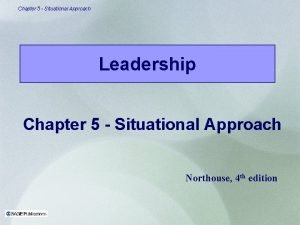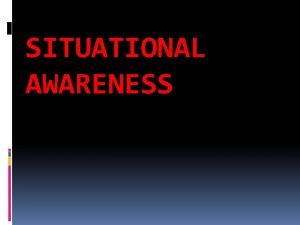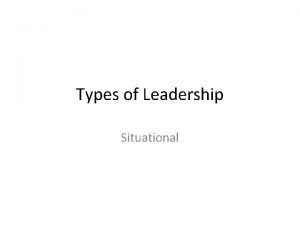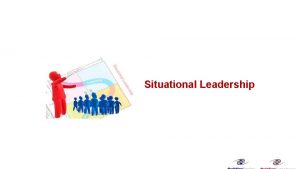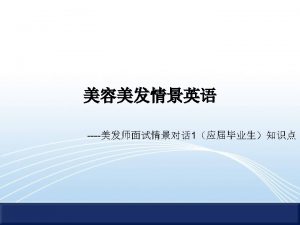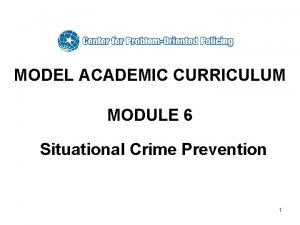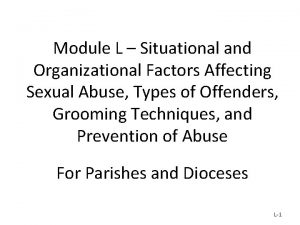SITUATIONAL ANALYSIS MODULE 2 SITUATIONAL ANALYSIS z The


































- Slides: 34

SITUATIONAL ANALYSIS MODULE 2

SITUATIONAL ANALYSIS z. The situational analysis is used to develop an optimal strategy to reach goals and objectives. z. Often referred to as SWOT; it is used to derive competitive advantage

SITUATIONAL ANALYSIS z. Assess organizational strengths and weaknesses by using Ansoff’s Grid of Competences

ANSOFF’S GRID OF COMPETENCES z. A 4 x 4 matrix that classifies skills & resources against functional areas. z. Skills and Resources: R&D, General Management, Operations, Marketing z. Functional Areas: facilities and equipment, personnel skills, organizational capabilities, management capabilities

MEASUREMENT OF STRENGTHS AND WEAKNESSES (158/159) COMPETITION STRATEGIC POSTURE PAST PERFORMANCE STRENGTHS & WEAKNESSES MARKETING EFFECTIVENESS MARKETING ENVIRONMENT

STRENGTHS: EXAMPLES (Text, pg 169) z Leadership in innovation z Ability to influence legislation z Efficient, low cost facilities z Availability of capital z Customer loyalty z Dominant market share z Quality sales force z Make and sell quality products

OPPORTUNITIES AND THREATS z. Political/ Legal z. Social/Cultural/Demographic z. Economic z. Technological

POLITICAL / LEGAL Managerial Questions z. What changes in regulations are possible? How will they impact demand for my product? z. What political risks exist in countries the firm wishes to expand to?

POLITICAL / LEGAL Methods of Analysis z. Analysis of regulations z. Environmental monitoring z. Public opinion polls

SOCIAL/CULTURAL/DEMO Managerial Questions z. What trends are emerging where the firm is operating? z. How would these trends impact the demand for existing products or help create new products? z. What trends of population growth & movement are emerging? z. How would these impact the firm?

SOCIAL/CULTURAL/DEMO Methods of Analysis z. Content analysis of popular press z. Lifestyle analysis z. General purpose consumer surveys z. Census data / projections

ECONOMIC Managerial Questions z. What are the economic prospects in the markets where the firm currently operates or plans to operate in the future? z. How would they affect the business?

ECONOMIC Methods of Analysis z. Macroeconomic forecasting models

TECHNOLOGICAL Managerial Questions z. What are some emerging technologies that will affect the current products and their processes? z. What are the life-cycle trends of the current technologies?

TECHNOLOGICAL Methods of Analysis z. Life Cycle Analysis z. Technological forecasting methods

SITUATIONAL ANALYSIS z. Competitor Analysis y. What are the strengths, weaknesses and limitations of our competitors?

ANALYZING THE COMPETITION z. Identify key competitors z. Analyze performance record z. Assess current satisfaction z. Identify marketing strategy z. Analyze resources and competencies z. Predict future behavior

COMPETITOR’S OBJECTIVES z. Financial goals z. Market share

COMPETITOR’S OBJECTIVES z. The parent’s objectives ywhat are they yoverall importance of SBU yhow successful has the parent been in the past

COMPETITOR’S STRATEGY z. Past strategies z. Present strategies

COMPETITOR’S SUCCESSES z. Provide insight into future actions

COMPETITOR’S WEAKNESSES z. Take advantage of weaknesses!

FUTURE BEHAVIOR z. What is their current level of satisfaction? z. How likely will they change? z. How effectively can the competitor respond to environmental changes?

GATHERING COMPETITIVE INFORMATION z. Recruits and employees of competing firms z. Customers z. Published materials and public documents z. Observation z. Trash analysis

“THE COMPETITION” z“The essence of strategy formulation is coping with competition. ” (Porter) z. We must be broad minded when looking at “the competition. ”

POTENTIAL COMPETITORS z. Current Competition z. Suppliers z. Potential Entrants z. Substitute Products z. Customers

FIVE FACTOR MODEL OF MARKET PROFITABILITY POTENTIAL ENTRANTS POWER OF SUPPLIERS EXISTING COMPETITORS SUBSTITUTE PRODUCTS POWER OF BUYERS

THREAT OF POTENTIAL ENTRANTS z. Barriers to Entry y. Incumbents’ cost advantages y. Product differentiation y. Capital requirements y. Access to distribution channels y. Government policies y. Switching costs

POWER OF SUPPLIERS z. Suppliers can be powerful if: yindustry is dominated by a few suppliers ythe industry of the customer is not important to the supplier group

POWER OF BUYERS z. Buyers can be powerful if they: yare few ypurchase in large volumes yearn low profits ycan find alternative suppliers

SUBSTITUTE PRODUCTS z. Substitute products limit the potential earnings of an industry by placing a ceiling on prices it can charge.

RIVALRY AMONG EXISTING COMPETITORS z. Rivalry will be intense if: ycompetitors are numerous/identical in size ythe product or service lacks differentiation ythere is high investment intensity

FROM THE INTERNET z. University of Arizona Libraries yhttp: //dizzy. library. arizona. edu/ library/teams/slrp/csa-html /csa_home. htm

FROM THE TEXT…. z. Pages 74 to 93 z. Pages 115 to 119 z. Pages 158 to 175
 C device module module 1
C device module module 1 Hát kết hợp bộ gõ cơ thể
Hát kết hợp bộ gõ cơ thể Ng-html
Ng-html Bổ thể
Bổ thể Tỉ lệ cơ thể trẻ em
Tỉ lệ cơ thể trẻ em Gấu đi như thế nào
Gấu đi như thế nào Tư thế worm breton là gì
Tư thế worm breton là gì Alleluia hat len nguoi oi
Alleluia hat len nguoi oi Môn thể thao bắt đầu bằng từ chạy
Môn thể thao bắt đầu bằng từ chạy Thế nào là hệ số cao nhất
Thế nào là hệ số cao nhất Các châu lục và đại dương trên thế giới
Các châu lục và đại dương trên thế giới Công thức tính thế năng
Công thức tính thế năng Trời xanh đây là của chúng ta thể thơ
Trời xanh đây là của chúng ta thể thơ Mật thư tọa độ 5x5
Mật thư tọa độ 5x5 Làm thế nào để 102-1=99
Làm thế nào để 102-1=99 độ dài liên kết
độ dài liên kết Các châu lục và đại dương trên thế giới
Các châu lục và đại dương trên thế giới Thơ thất ngôn tứ tuyệt đường luật
Thơ thất ngôn tứ tuyệt đường luật Quá trình desamine hóa có thể tạo ra
Quá trình desamine hóa có thể tạo ra Một số thể thơ truyền thống
Một số thể thơ truyền thống Cái miệng xinh xinh thế chỉ nói điều hay thôi
Cái miệng xinh xinh thế chỉ nói điều hay thôi Vẽ hình chiếu vuông góc của vật thể sau
Vẽ hình chiếu vuông góc của vật thể sau Nguyên nhân của sự mỏi cơ sinh 8
Nguyên nhân của sự mỏi cơ sinh 8 đặc điểm cơ thể của người tối cổ
đặc điểm cơ thể của người tối cổ Thế nào là giọng cùng tên
Thế nào là giọng cùng tên Vẽ hình chiếu đứng bằng cạnh của vật thể
Vẽ hình chiếu đứng bằng cạnh của vật thể Fecboak
Fecboak Thẻ vin
Thẻ vin đại từ thay thế
đại từ thay thế điện thế nghỉ
điện thế nghỉ Tư thế ngồi viết
Tư thế ngồi viết Diễn thế sinh thái là
Diễn thế sinh thái là Dot
Dot Số nguyên tố là gì
Số nguyên tố là gì Tư thế ngồi viết
Tư thế ngồi viết





































